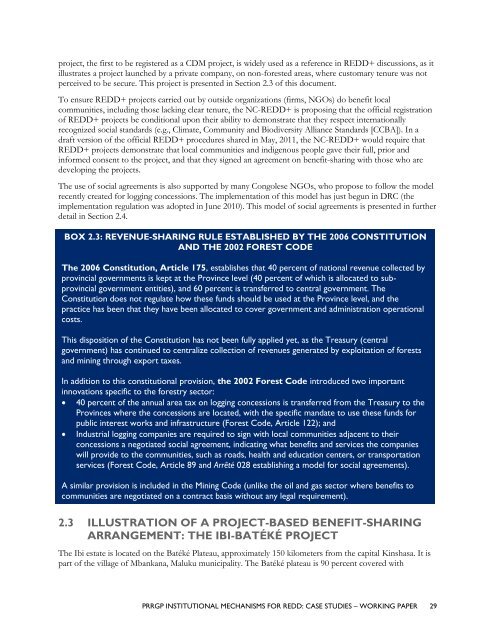Institutional Mechanisms for REDD+ - Case Studies Working Paper
Institutional Mechanisms for REDD+ - Case Studies Working Paper
Institutional Mechanisms for REDD+ - Case Studies Working Paper
Create successful ePaper yourself
Turn your PDF publications into a flip-book with our unique Google optimized e-Paper software.
project, the first to be registered as a CDM project, is widely used as a reference in <strong>REDD+</strong> discussions, as it<br />
illustrates a project launched by a private company, on non-<strong>for</strong>ested areas, where customary tenure was not<br />
perceived to be secure. This project is presented in Section 2.3 of this document.<br />
To ensure <strong>REDD+</strong> projects carried out by outside organizations (firms, NGOs) do benefit local<br />
communities, including those lacking clear tenure, the NC-<strong>REDD+</strong> is proposing that the official registration<br />
of <strong>REDD+</strong> projects be conditional upon their ability to demonstrate that they respect internationally<br />
recognized social standards (e.g., Climate, Community and Biodiversity Alliance Standards [CCBA]). In a<br />
draft version of the official <strong>REDD+</strong> procedures shared in May, 2011, the NC-<strong>REDD+</strong> would require that<br />
<strong>REDD+</strong> projects demonstrate that local communities and indigenous people gave their full, prior and<br />
in<strong>for</strong>med consent to the project, and that they signed an agreement on benefit-sharing with those who are<br />
developing the projects.<br />
The use of social agreements is also supported by many Congolese NGOs, who propose to follow the model<br />
recently created <strong>for</strong> logging concessions. The implementation of this model has just begun in DRC (the<br />
implementation regulation was adopted in June 2010). This model of social agreements is presented in further<br />
detail in Section 2.4.<br />
BOX 2.3: REVENUE-SHARING RULE ESTABLISHED BY THE 2006 CONSTITUTION<br />
AND THE 2002 FOREST CODE<br />
The 2006 Constitution, Article 175, establishes that 40 percent of national revenue collected by<br />
provincial governments is kept at the Province level (40 percent of which is allocated to subprovincial<br />
government entities), and 60 percent is transferred to central government. The<br />
Constitution does not regulate how these funds should be used at the Province level, and the<br />
practice has been that they have been allocated to cover government and administration operational<br />
costs.<br />
This disposition of the Constitution has not been fully applied yet, as the Treasury (central<br />
government) has continued to centralize collection of revenues generated by exploitation of <strong>for</strong>ests<br />
and mining through export taxes.<br />
In addition to this constitutional provision, the 2002 Forest Code introduced two important<br />
innovations specific to the <strong>for</strong>estry sector:<br />
� 40 percent of the annual area tax on logging concessions is transferred from the Treasury to the<br />
Provinces where the concessions are located, with the specific mandate to use these funds <strong>for</strong><br />
public interest works and infrastructure (Forest Code, Article 122); and<br />
� Industrial logging companies are required to sign with local communities adjacent to their<br />
concessions a negotiated social agreement, indicating what benefits and services the companies<br />
will provide to the communities, such as roads, health and education centers, or transportation<br />
services (Forest Code, Article 89 and Arrêté 028 establishing a model <strong>for</strong> social agreements).<br />
A similar provision is included in the Mining Code (unlike the oil and gas sector where benefits to<br />
communities are negotiated on a contract basis without any legal requirement).<br />
2.3 ILLUSTRATION OF A PROJECT-BASED BENEFIT-SHARING<br />
ARRANGEMENT: THE IBI-BATÉKÉ PROJECT<br />
The Ibi estate is located on the Batéké Plateau, approximately 150 kilometers from the capital Kinshasa. It is<br />
part of the village of Mbankana, Maluku municipality. The Batéké plateau is 90 percent covered with<br />
PRRGP INSTITUTIONAL MECHANISMS FOR REDD: CASE STUDIES – WORKING PAPER 29

















